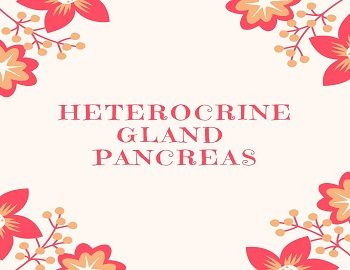Heterocrine Gland Pancreas:
The pancreas is a heterocrine gland. It is an elongated, yellowish, second largest gland located in the loop of the duodenum lying interior to the stomach. A large pancreatic duct runs across the gland, carrying enzymes and other exocrine secretion of acinar cells to the small intestine. The endocrine part of the pancreas is formed of groups of epithelial cells called Islets of Langerhans, scattered in the connective tissue between acini (Exocrine part) of the pancreas. The Islets of Langerhans consists of chiefly two types of cells i.e. α-cells and β-cells.
- Alpha cells (α-cells)- Also called Oxyphils. These form 60-70% of Islets of Langerhans. α-cells secrete a hormone called glucagon.
- Beta cells (β-cells)- These cells form 25-30% of the islet cells and secrete insulin hormone.
In addition to these two prime type of cells, the Islets of Langerhans also show the presence of the following types of cells-
- Gamma cells (γ-cells)-These secrete Gastrin.
- Delta cells (δ-cells)- These cells produce somatostatin– a growth-inhibiting hormone.
- F cells- These cells produce pancreatic polypeptides.
Important Functions of Pancreatic Hormones:
(1) Insulin- Insulin is also called Hypoglycaemic or antidiabetic factor as it prevents or decreases the glucose level in blood and prevent diabetes. It is secreted by β-cells of islets. Secretion of insulin is stimulated by a rise in blood glucose level (normal is 60-100mg/100ml of blood) or a rise in amino acid concentration in blood. It is an anabolic hormone and performs following functions-
- It promotes glucose absorption by cells for respiration.
- It promotes glucose absorption by the liver and muscles for glycogenesis or conversion of glucose into glycogen.
- It helps in the conversion of glucose to fatty acids.
- It reduces the amino acids content of blood by promoting their absorption by individual cells and the formation of proteins in them.
- It increases fat synthesis in adipose tissue from fatty acids.
- It reduces the fat oxidation and breakdown of food.
- Reduction in protein breakdown i.e. catabolism of proteins.
- It decreases the formation of ketone bodies.
- Increased stored protein in the tissue.
- It converts glucose into glycogen, thus lowers the glucose content of the blood. It is antagonistic to glycogen.
Hypoactivity or degeneration of β-cells leads to the deficiency of insulin which causes diabetes mellitus. It is characterized by rising in blood sugar level (about 3 times), excessive urination, excessive thirst, increased loss of water from the body. Degradation of fats produces ketones bodies in blood and urine, blood cholesterol level rises, breakdown of proteins increases wasting of body tissues. Healing power is impaired. Diabetic patients have blurred vision. In extreme cases, the patient may pass into a diabetic coma and ultimately dies. A controlled dose of insulin and a sugar-free diet is the best preventive measures for diabetes mellitus.
(2) Glucagon- Glucagon a hyperglycaemic or diabetogenic polypeptide hormone secreted by the α-cells of islets of Langerhans. Its secretion is stimulated by low blood sugar level. Glucagon is antagonistic to insulin. It increases the sugar level in the blood by promoting glycogenolysis in liver cells, increasing gluconeogenesis and inhibiting the conversion of glucose to lactic acid.
(3) Somatostatin- It is released by δ-cells. It keeps a check on the excessive secretion of α and β cells i.e. it acts as an inhibitor for both insulin and glucagon. It also inhibits the secretion of growth hormone from the hypothalamus and decreases the rate of nutrient absorption from the gastrointestinal tract.
(4) Gastrin- It is secreted by γ-cells, helps in stimulation of the gastric glands for the release of gastric juice.
(5) Pancreatic Polypeptide- It is secreted by F cells and act as an inhibitor to the secretion of pancreatic juice.









Comments (No)